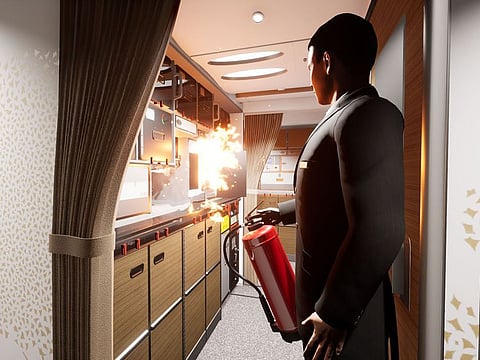Emirates cabin crew to get safety training on virtual platform MIRA
Airline’s 23,000 crew members will soon be able to train on MIRA

Dubai: Emirates’ cabin crew members will be able to complete their recurrent safety and emergency procedures (SEP) training on the airline’s immersive virtual training platform, MIRA, the airline announced Wednesday. Dubai’s flagship airline, which employs nearly 23,000 cabin crew and is growing, uses MIRA, a platform that uses extended reality (XR) to train new joiners.
The self-guided virtual training platform has been designed to meet the requirements of GCAA and other regulatory bodies while maintaining the integrity and quality of Emirates’ training programmes, the airline said in a statement. Emirates debuted MIRA in November 2023.
“The platform features photorealistic, high-fidelity, fully modelled cabin interiors of the Airbus A380, Boeing 777 and Airbus A350 aircraft, plus emergency slides, tarmac, airbridges and different views of water and land,” said Emirates. Moreover, it would be supported with hyper-realistic audio and images. “Multi-player scenarios with avatars playing the part of backup crew members will ensure standard operating procedures are accurately replicated,” Emirates said.
Emirates’ cabin crew's core responsibilities are to ensure onboard safety. The SEP training on MIRA will initially start with two modules – aircraft door operations and fire-fighting – which are key aspects of onboard safety.
Crew members undergo annual SEP training, which will now feature virtual door drills to assess their skills in normal and emergency procedures.
Fire-fighting skills are also key in the cabin crew competency arsenal. MIRA will feature a host of scenarios for fires in ovens, overhead lockers, and toilets. The cabin crew will demonstrate their skills using a fully modelled fire extinguisher with visual and audio effects of smoke, flames, and extinguishing agents.
Capt Bader Al Marzooqi, Senior Vice President of Flight Training, said, “At Emirates, we are priming our crew for the airline’s next era of growth and expansion by integrating the latest innovations with our leadership, best practices, and excellence in training.”
He added, “With our ambitious growth roadmap—315 aircraft on order and 30,000 cabin crew by 2030—effective and efficient SEP training is an absolute must. With MIRA, we can now quickly and significantly scale up our crew training to meet business demands. This is a bold, brave, and strategic move that has shaped our training ethos for the future.”
The 3D modules with virtual reality headsets can be run in three modes: Teach, Practice and Assessment. Around 8-10 cabin crew can simultaneously be trained and assessed in their own VR space on the same scenario. Trainers and facilitators can rely on various metrics to fine-tune training programmes.
A 2D version, accessed on all mobile devices, laptops, and desktops, means cabin crew will no longer need to travel to training venues with restrictive schedules. The training team can recreate complex or dangerous situations of any intensity in a safe environment, said Emirates.
This will ensure that the crew can practise worst-case scenarios and make mistakes until they’re fully competent and confident in dealing with emergencies onboard. Training on MIRA can also help calm the nerves of new cabin crew as it can be done repeatedly, reinforcing their knowledge and understanding engagingly.
Sign up for the Daily Briefing
Get the latest news and updates straight to your inbox



